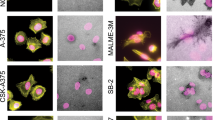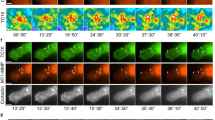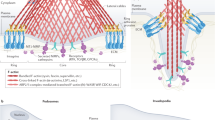Abstract
Cancer metastasis involves multiple steps including detachment of the metastatic cells from neighboring cells, the acquisition of motility and invasion to other tissue. All of these steps require the reorganization of the actin cytoskeleton. In this study, we found that the protein palladin, a molecular scaffold with an important function in actin organization, is expressed at higher overall levels in tumors compared with benign breast tissue, and also expressed significantly higher in four invasive breast cancer cell lines when compared with four non-invasive cell lines. In addition, we found that palladin plays a key role in the formation of podosomes. Podosomes are actin-rich structures that function in adhesion and matrix degradation, and have been found in many invasive cell types. Our results show that phorbol ester treatment stimulated the formation of palladin-containing podosomes in invasive, but not in non-invasive cell lines. More importantly, palladin knockdown resulted in decreased podosome formation and a significant reduction in transwell migration and invasive motility. Palladin overexpression induced podosome formation in the non-invasive MCF7 cells, which are otherwise unable to form podosomes, suggesting that palladin plays a critical role in the assembly of podosomes. Overall, these results indicate that palladin overexpression contributes to the invasive behavior of metastatic cells.
This is a preview of subscription content, access via your institution
Access options
Subscribe to this journal
Receive 50 print issues and online access
$259.00 per year
only $5.18 per issue
Buy this article
- Purchase on Springer Link
- Instant access to full article PDF
Prices may be subject to local taxes which are calculated during checkout






Similar content being viewed by others
References
Boukhelifa M, Hwang SJ, Valtschanoff JG, Meeker RB, Rustioni A, Otey CA . (2003). A critical role for palladin in astrocyte morphology and response to injury. Mol Cell Neurosci 23: 661–668.
Boukhelifa M, Moza M, Johansson T, Rachlin A, Parast M, Huttelmaier S et al. (2006). The proline-rich protein palladin is a binding partner for profilin. FEBS J 273: 26–33.
Boukhelifa M, Parast MM, Bear JE, Gertler FB, Otey CA . (2004). Palladin is a novel binding partner for Ena/VASP family members. Cell Motil Cytoskeleton 58: 17–29.
Boukhelifa M, Parast MM, Valtschanoff JG, LaMantia AS, Meeker RB, Otey CA . (2001). A role for the cytoskeleton-associated protein palladin in neurite outgrowth. Mol Biol Cell 12: 2721–2729.
Bowden ET, Barth M, Thomas D, Glazer RI, Mueller SC . (1999). An invasion-related complex of cortactin, paxillin and PKCmu associates with invadopodia at sites of extracellular matrix degradation. Oncogene 18: 4440–4449.
Buccione R, Orth JD, McNiven MA . (2004). Foot and mouth: podosomes, invadopodia and circular dorsal ruffles. Nat Rev Mol Cell Biol 5: 647–657.
Calle Y, Burns S, Thrasher AJ, Jones GE . (2006). The leukocyte podosome. Eur J Cell Biol 85: 151–157.
Carman CV, Sage PT, Sciuto TE, de la Fuente MA, Geha RS, Ochs HD et al. (2007). Transcellular diapedesis is initiated by invasive podosomes. Immunity 26: 784–797.
Di Modugno F, DeMonte L, Balsamo M, Bronzi G, Nicotra MR, Alessio M et al. (2007). Molecular cloning of hMena (ENAH) and its splice variant hMena+11a: epidermal growth factor increases their expression and stimulates hMena+11a phosphorylation in breast cancer cell lines. Cancer Res 67: 2657–2665.
Dixon RD, Arneman DK, Rachlin AS, Sundaresan NR, Costello MJ, Campbell SL et al. (2008). Palladin is an actin cross-linking protein that uses immunoglobulin-like domains to bind filamentous actin. J Biol Chem 283: 6222–6231.
Dumitrescu RG, Cotarla I . (2005). Understanding breast cancer risk—where do we stand in 2005? J Cell Mol Med 9: 208–221.
Flanagan L, Van Weelden K, Ammerman C, Ethier SP, Welsh J . (1999). SUM-159PT cells: a novel estrogen independent human breast cancer model system. Breast Cancer Res Treat 58: 193–204.
Gimona M, Buccione R . (2006). Adhesions that mediate invasion. Int J Biochem Cell Biol 38: 1875–1892.
Gimona M, Kaverina I, Resch GP, Vignal E, Burgstaller G . (2003). Calponin repeats regulate actin filament stability and formation of podosomes in smooth muscle cells. Mol Biol Cell 14: 2482–2491.
Goicoechea S, Arneman D, Disanza A, Garcia-Mata R, Scita G, Otey CA . (2006). Palladin binds to Eps8 and enhances the formation of dorsal ruffles and podosomes in vascular smooth muscle cells. J Cell Sci 119: 3316–3324.
Gringel A, Walz D, Rosenberger G, Minden A, Kutsche K, Kopp P et al. (2006). PAK4 and alphaPIX determine podosome size and number in macrophages through localized actin regulation. J Cell Physiol 209: 568–579.
Grunewald TG, Kammerer U, Kapp M, Eck M, Dietl J, Butt E et al. (2007a). Nuclear localization and and cytosolic overexpression of LASP-1 correlates with tumor size and nodal-positivity of human breast carcinoma. BMC Cancer 7: 198.
Grunewald TG, Kammerer U, Schulze E, Schindler D, Honig A, Zimmer M et al. (2006). Silencing of LASP-1 influences zyxin localization, inhibits proliferation and reduces migration in breast cancer cells. Exp Cell Res 312: 974–982.
Grunewald TG, Kammerer U, Winkler C, Schindler D, Sickmann A, Honig A et al. (2007b). Overexpression of LASP-1 mediates migration and proliferation of human ovarian cancer cells and influences zyxin localisation. Br J Cancer 96: 296–305.
Hai CM, Hahne P, Harrington EO, Gimona M . (2002). Conventional protein kinase C mediates phorbol-dibutyrate-induced cytoskeletal remodeling in a7r5 smooth muscle cells. Exp Cell Res 280: 64–74.
Hatakeyama H, Kondo T, Fujii K, Nakanishi Y, Kato H, Fukuda S et al. (2006). Protein clusters associated with carcinogenesis, histological differentiation and nodal metastasis in esophageal cancer. Proteomics 6: 6300–6316.
Honda K, Yamada T, Endo R, Ino Y, Gotoh M, Tsuda H et al. (1998). Actinin-4, a novel actin-bundling protein associated with cell motility and cancer invasion. J Cell Biol 140: 1383–1393.
Jin L, Kern MJ, Otey CA, Wamhoff BR, Somlyo AV . (2007). Angiotensin II, focal adhesion kinase, and PRX1 enhance smooth muscle expression of lipoma preferred partner and its newly identified binding partner palladin to promote cell migration. Circ Res 100: 817–825.
Kelly T, Yan Y, Osborne RL, Athota AB, Rozypal TL, Colclasure JC et al. (1998). Proteolysis of extracellular matrix by invadopodia facilitates human breast cancer cell invasion and is mediated by matrix metalloproteinases. Clin Exp Metastasis 16: 501–512.
Kuperwasser C, Dessain S, Bierbaum BE, Garnet D, Sperandio K, Gauvin GP et al. (2005). A mouse model of human breast cancer metastasis to human bone. Cancer Res 65: 6130–6138.
Lin YH, Park ZY, Lin D, Brahmbhatt AA, Rio MC, Yates III JR et al. (2004). Regulation of cell migration and survival by focal adhesion targeting of Lasp-1. J Cell Biol 165: 421–432.
Linder S . (2007). The matrix corroded: podosomes and invadopodia in extracellular matrix degradation. Trends Cell Biol 17: 107–117.
Linder S, Aepfelbacher M . (2003). Podosomes: adhesion hot-spots of invasive cells. Trends Cell Biol 13: 376–385.
Luo H, Liu X, Wang F, Huang Q, Shen S, Wang L et al. (2005). Disruption of palladin results in neural tube closure defects in mice. Mol Cell Neurosci 29: 507–515.
Monsky WL, Lin CY, Aoyama A, Kelly T, Akiyama SK, Mueller SC et al. (1994). A potential marker protease of invasiveness, seprase, is localized on invadopodia of human malignant melanoma cells. Cancer Res 54: 5702–5710.
Mykkanen OM, Gronholm M, Ronty M, Lalowski M, Salmikangas P, Suila H et al. (2001). Characterization of human palladin, a microfilament-associated protein. Mol Biol Cell 12: 3060–3073.
Parast MM, Otey CA . (2000). Characterization of palladin, a novel protein localized to stress fibers and cell adhesions. J Cell Biol 150: 643–656.
Pogue-Geile KL, Chen R, Bronner MP, Crnogorac-Jurcevic T, Moyes KW, Dowen S et al. (2006). Palladin mutation causes familial pancreatic cancer and suggests a new cancer mechanism. PLoS Med 3: e516.
Rachlin AS, Otey CA . (2006). Identification of palladin isoforms and characterization of an isoform-specific interaction between Lasp-1 and palladin. J Cell Sci 119: 995–1004.
Ronty M, Taivainen A, Heiska L, Otey C, Ehler E, Song WK et al. (2007). Palladin interacts with SH3 domains of SPIN90 and Src and is required for Src-induced cytoskeletal remodeling. Exp Cell Res 313: 2575–2585.
Ronty M, Taivainen A, Moza M, Kruh GD, Ehler E, Carpen O . (2005). Involvement of palladin and alpha-actinin in targeting of the Abl/Arg kinase adaptor ArgBP2 to the actin cytoskeleton. Exp Cell Res 310: 88–98.
Ronty M, Taivainen A, Moza M, Otey CA, Carpen O . (2004). Molecular analysis of the interaction between palladin and alpha-actinin. FEBS Lett 566: 30–34.
Ronty MJ, Leivonen SK, Hinz B, Rachlin A, Otey CA, Kahari VM et al. (2006). Isoform-specific regulation of the actin-organizing protein palladin during TGF-beta1-induced myofibroblast differentiation. J Invest Dermatol 126: 2387–2396.
Roy P, Jacobson K . (2004). Overexpression of profilin reduces the migration of invasive breast cancer cells. Cell Motil Cytoskeleton 57: 84–95.
Ryu B, Jones J, Hollingsworth MA, Hruban RH, Kern SE . (2001). Invasion-specific genes in malignancy: serial analysis of gene expression comparisons of primary and passaged cancers. Cancer Res 61: 1833–1838.
Seals DF, Azucena Jr EF, Pass I, Tesfay L, Gordon R, Woodrow M et al. (2005). The adaptor protein Tks5/Fish is required for podosome formation and function, and for the protease-driven invasion of cancer cells. Cancer Cell 7: 155–165.
Suehara Y, Kondo T, Fujii K, Hasegawa T, Kawai A, Seki K et al. (2006). Proteomic signatures corresponding to histological classification and grading of soft-tissue sarcomas. Proteomics 6: 4402–4409.
Wang W, Goswami S, Lapidus K, Wells AL, Wyckoff JB, Sahai E et al. (2004). Identification and testing of a gene expression signature of invasive carcinoma cells within primary mammary tumors. Cancer Res 64: 8585–8594.
Wang W, Goswami S, Sahai E, Wyckoff JB, Segall JE, Condeelis JS . (2005). Tumor cells caught in the act of invading: their strategy for enhanced cell motility. Trends Cell Biol 15: 138–145.
Welsch T, Endlich K, Giese T, Buchler MW, Schmidt J . (2007). Eps8 is increased in pancreatic cancer and required for dynamic actin-based cell protrusions and intercellular cytoskeletal organization. Cancer Lett 255: 205–218.
Wittenmayer N, Jandrig B, Rothkegel M, Schluter K, Arnold W, Haensch W et al. (2004). Tumor suppressor activity of profilin requires a functional actin binding site. Mol Biol Cell 15: 1600–1608.
Yamaguchi H, Condeelis J . (2007). Regulation of the actin cytoskeleton in cancer cell migration and invasion. Biochim Biophys Acta 1773: 642–652.
Yamaguchi H, Pixley F, Condeelis J . (2006). Invadopodia and podosomes in tumor invasion. Eur J Cell Biol 85: 213–218.
Zajchowski DA, Bartholdi MF, Gong Y, Webster L, Liu HL, Munishkin A et al. (2001). Identification of gene expression profiles that predict the aggressive behavior of breast cancer cells. Cancer Res 61: 5168–5178.
Zhang J, Park SI, Artime MC, Summy JM, Shah AN, Bomser JA et al. (2007). AFAP-110 is overexpressed in prostate cancer and contributes to tumorigenic growth by regulating focal contacts. J Clin Invest 117: 2962–2973.
Acknowledgements
We are grateful to the following former lab members for their assistance in the early stages of this project: Dr Mana Parast, Amir Aghajanian and Xinshuo Wang. We thank Xiaoya Ding and Dave Cowan for help with immunohistochemistry. We also thank Dr Cercina Onesto for kindly sharing the breast cancer cell lines. This work was supported by NIH Grant GM61743 (to CO). HJK was supported by NIH K08 Grant CA098240 and BB was supported by NIH training Grant CA09688.
Author information
Authors and Affiliations
Corresponding author
Additional information
Supplementary Information accompanies the paper on the Oncogene website (http://www.nature.com/onc)
Supplementary information
Rights and permissions
About this article
Cite this article
Goicoechea, S., Bednarski, B., García-Mata, R. et al. Palladin contributes to invasive motility in human breast cancer cells. Oncogene 28, 587–598 (2009). https://doi.org/10.1038/onc.2008.408
Received:
Revised:
Accepted:
Published:
Issue Date:
DOI: https://doi.org/10.1038/onc.2008.408
Keywords
This article is cited by
-
miR-182 suppresses invadopodia formation and metastasis in non-small cell lung cancer by targeting cortactin gene
Journal of Experimental & Clinical Cancer Research (2018)
-
Palladin is a novel microtubule-associated protein responsible for spindle orientation
Scientific Reports (2017)
-
Real-time imaging of microparticles and living cells with CMOS nanocapacitor arrays
Nature Nanotechnology (2015)
-
Palladin is Upregulated in Kidney Disease and Contributes to Epithelial Cell Migration After Injury
Scientific Reports (2015)
-
Amplification and deletion of the RAPH1 gene in breast cancer patients
Molecular Biology Reports (2013)



